Black ladybugs have a unique look which is sometimes associated with deep symbolism. These ladybugs are very common.
There are more than 6.000 ladybug species around the world. Red ladybugs and yellow ladybugs are mostly met with feelings of joy. Black ladybugs are mistakenly believed to be poisonous, but they can be as friendly as red or yellow ladybugs.
Table of Contents
Why Are Some Ladybugs Black?
Some ladybugs are black to deter potential predators. Black is solely the main color of a black ladybug as it’s most often combined with other colors, spots, and stripes.
Aposematic coloration is specific to black ladybugs. This is a type of coloring that deters potential predators. However, some birds might not be deterred by the black color of these ladybugs.
The extent to which black deters predators compared to red or yellow isn’t known. However, it’s believed many potential predators think of black ladybugs as potentially poisonous while keeping a safe distance.
Types of Black Ladybugs
1. Twice-stabbed Lady Beetle

These black ladybugs (Chilocorus Stigma) are known for their twin red spots. Almost entirely black, the Twice-stabbed Lady Beetle is seen as a beneficial species to farmers and homeowners.
These ladybugs are known to eat insects that eat plant leaves and plant fungi, essentially eliminating invasive plant species.
Even with their black bodies, they are seen as beneficial insects.
Some predators believe these ladybugs to be poisonous. But they can only emit bad smells, mainly in the case of the females.
These ladybugs are also known to taste very bad which might make some predators think twice when it comes to eating them.
2. Mealybug Destroyer
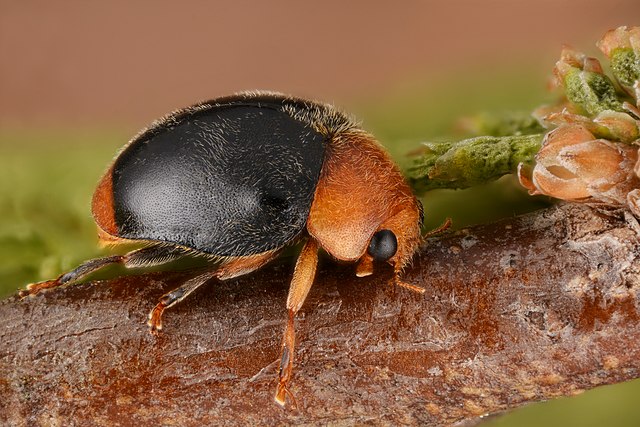
These black ladybugs (Cryptolaemus Montrouzieri) are known for eating scale insects, scale insect eggs, and even cockroach eggs. A beneficial role in farming is attributed to the species.
Mealybug Destroyers are known to grow to an average size of 1/6 inches. They are present across most states and identified by their black and brown bodies.
These black ladybugs are also purchased by farmers to control aphids and other insects that eat plants.
It’s recommended to purchase 500 Mealybug Destroyers for each crop acre or less than 100 Mealybug Destroyers for greenhouse crops.
3. Cactus Lady Beetle
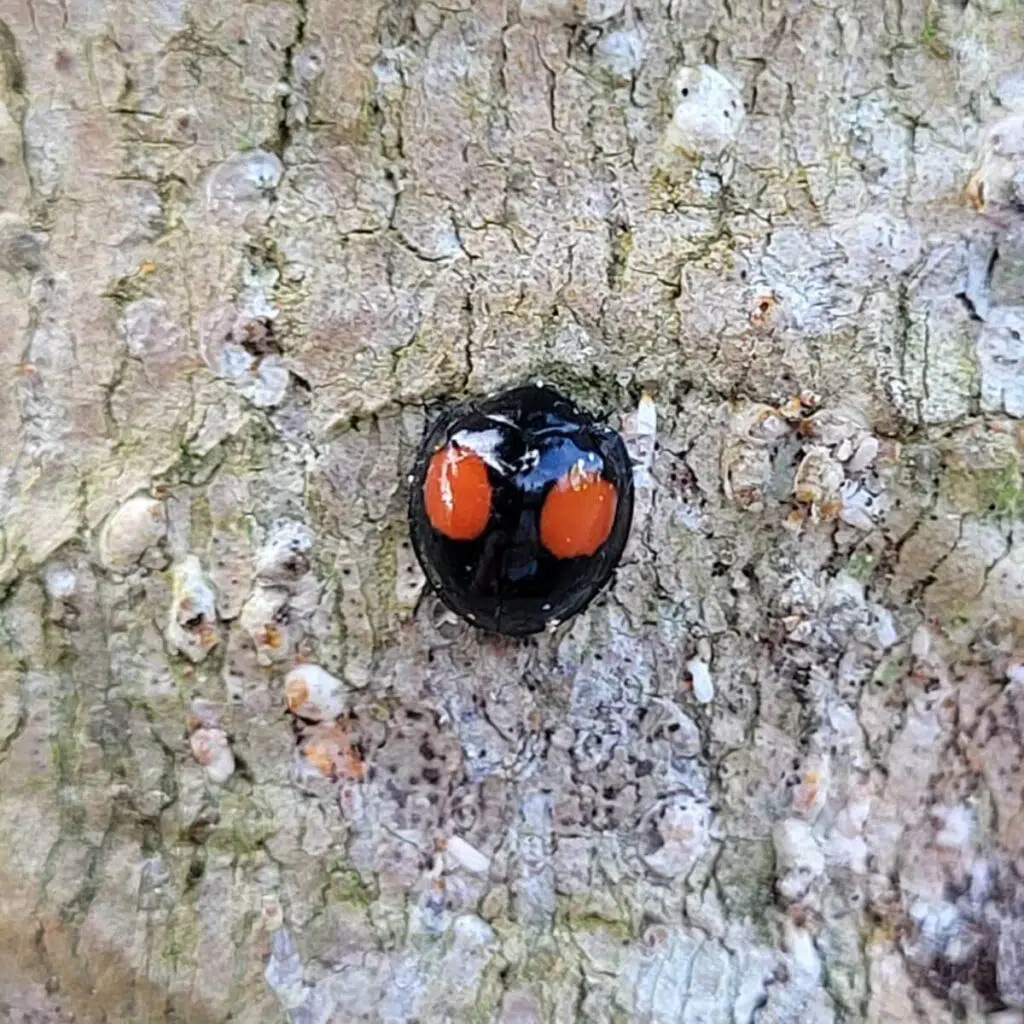
The Cactus Lady Beetle (Chilocorus Cacti) is identified by a black body with red spots. These ladybugs are known to live in North America and regions of Central America.
Like other lady beetles, these bugs are predators. They are known to eat scale insects.
However, successfully using Cactus Lady Beetles on crops has not yet been reported. Various attempts to use the species to control insects that attack crops have led to inconclusive results.
4. Ursine Spurleg Lady Beetle

This species of black ladybugs (Brachiacantha Ursina) are easy to identify. It features colored spots across the elytra, similar to most other black ladybugs.
5 orange spots are identified on each wing of these bugs. Their head is also known to have both black and orange coloring.
The species is known for eating scale insects. They also consume aphids.
One of the distinct traits of the Ursine Spurleg Lady Beetle is the capacity of the species to eat tree scale insects.
5. Twice-struck Lady Beetle

This ladybug species (Axion Plagiatum) is known for resembling the Twice-Stabbed Lady Beetle. However, it has larger yellow or orange spots on its wings.
One red or orange spot is seen on each wing of this black ladybug.
Its body shape also tends to be different than the dome-shaped Twice-Stabbed Lady Beetle. The Twice-struck Lady Beetle has a flatter body.
The habitat of this species also helps it separate itself from other similar black ladybugs.
Bugs of this species are only found in the US and the Caribbean.
6. Pine Ladybird

The Pine Ladybird (Exochomus Quadripustulatus) is one of the black ladybugs that also features red spots or red marks. One of the traits of the species is that it has one red spot and one red mark on each wing.
Pine ladybirds are seen as beneficial insects as they feed on several pest insects such as aphids or scale insects.
The end of spring and the beginning of the summer is the best time to see Pine ladybirds as they start to become very active as the weather gets warmer.
7. Bigeminate Sigil Lady Beetle
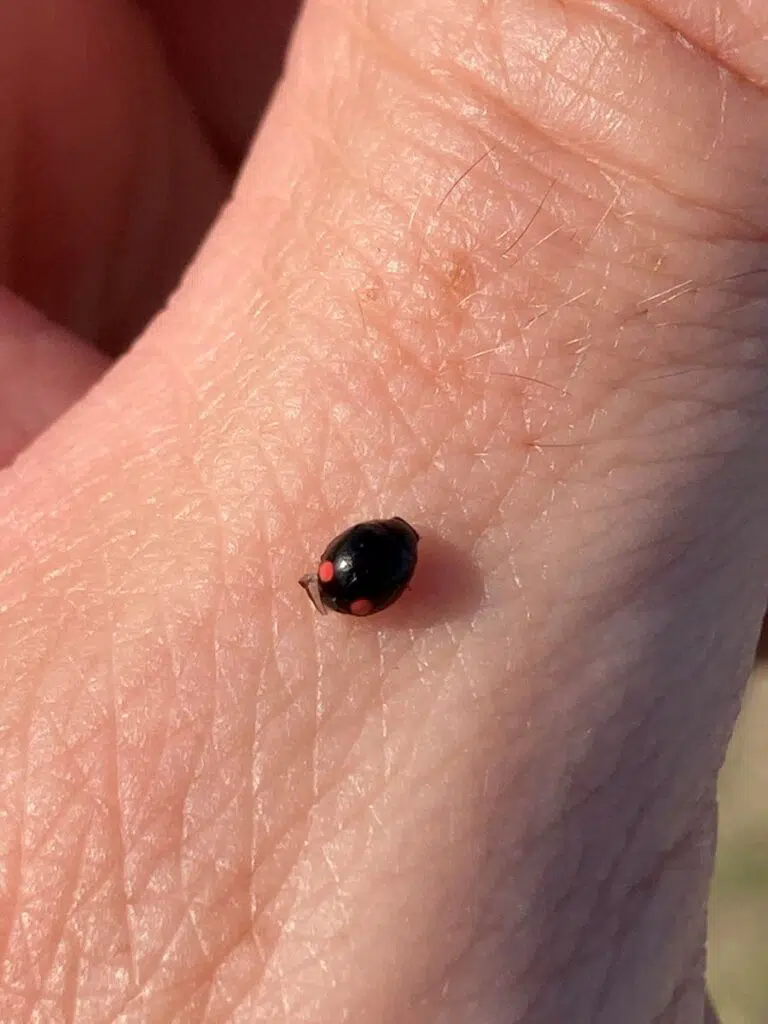
Mealybugs and scale insects are the preferred food for the Bigeminate Sigil Lady Beetle.
This species of lady beetle (Hyperaspis Bigeminata) is often seen on trees and identified by its black and red body.
Most of the body of this species is black. There are 4 red spots on the elytra, 2 on the base of the wings, and 2 at the tip of the wings.
8. Thrice-struck Lady Beetle
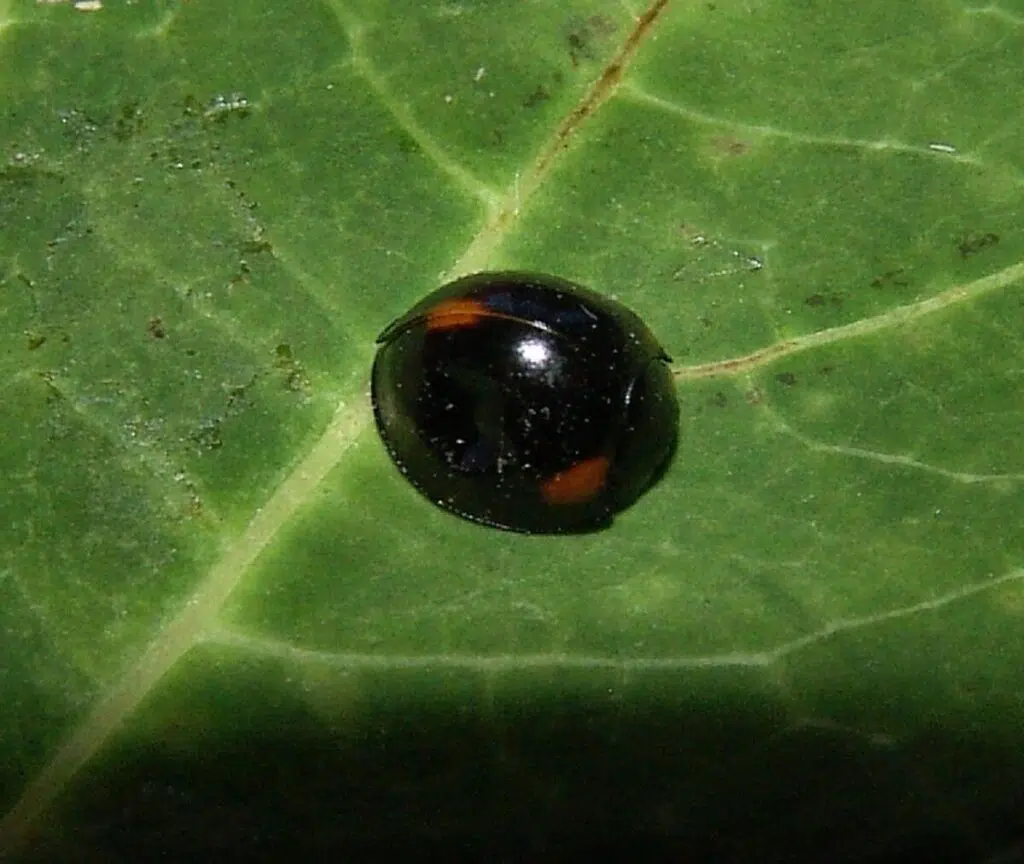
This dome-shaped ladybug (Axion Tripustulatum) is used in agriculture to control pests, as it has a predatory profile.
Black and red coloring are specific to the Thrice-struck lady Beetle. Red spots (sometimes orange) are seen next to the head and on the head of this ladybug.
The positioning of the red spots allows easier identification since the Thrice-struck Lady Beetle resembles the Twice-stabbed Lady Beetle.
9. Four-eyed Sigil Lady Beetle
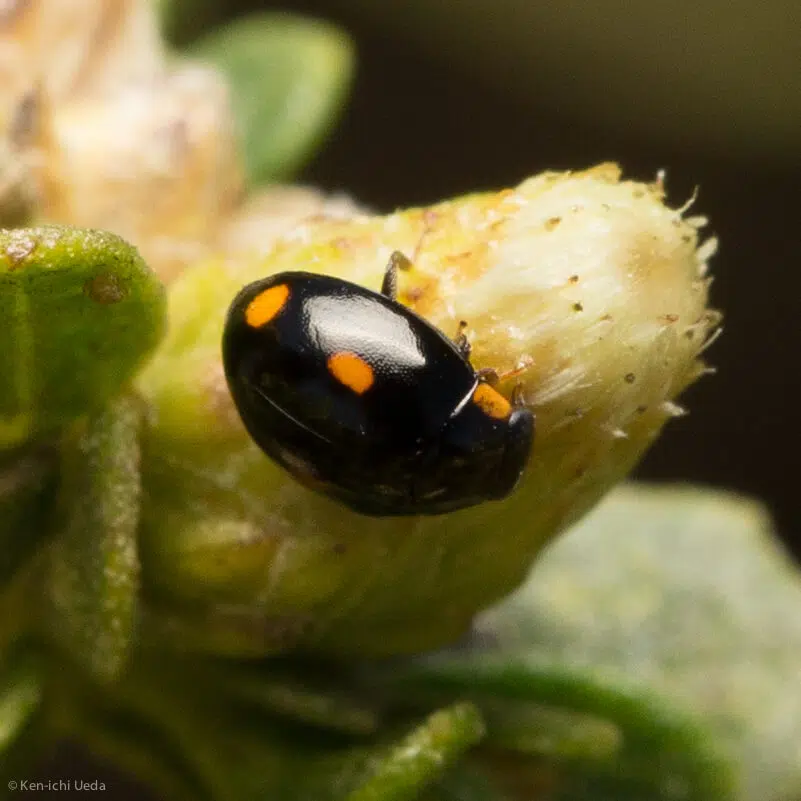
This species (Hyperaspis Quadrioculata) is known for having a black body and 4 colored spots, typically orange spots. It grows to 4 mm albeit most measured bugs average 2.7mm.
These black ladybugs are found across the US. They are mostly seen in woodlands.
It’s not rare to see these black ladybugs in gardens or parks. They might be looking for scale insects in wider areas.
The end of summer marks the year where most Four-eyed Sigil Lady Beetles are seen.
10. Lateral Sigil Lady Beetle
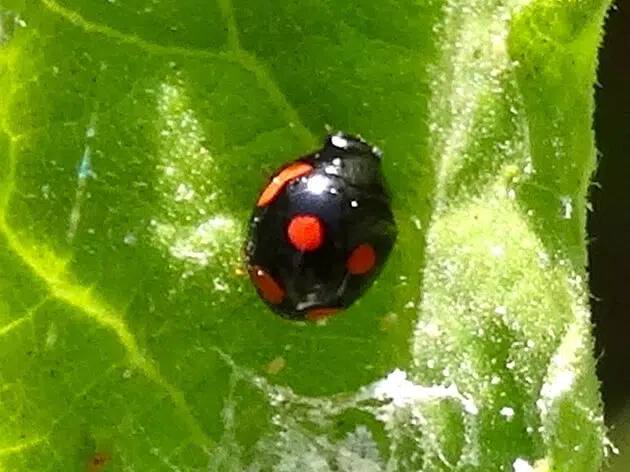
Lateral Sigil Lady Beetles (Hyperaspis Lateralis) get their name from the lateral red marks on their bodies.
This species of black ladybugs are known for having anywhere between 1 and 4 red marks.
Some of these marks are spots while others resemble thick red lines on the sides of the black dome-shaped bug.
Known for eating scale insects, Lateral Sigil Lady Beetles are mostly found in woodlands.
11. Kuwana’s Lady Beetle
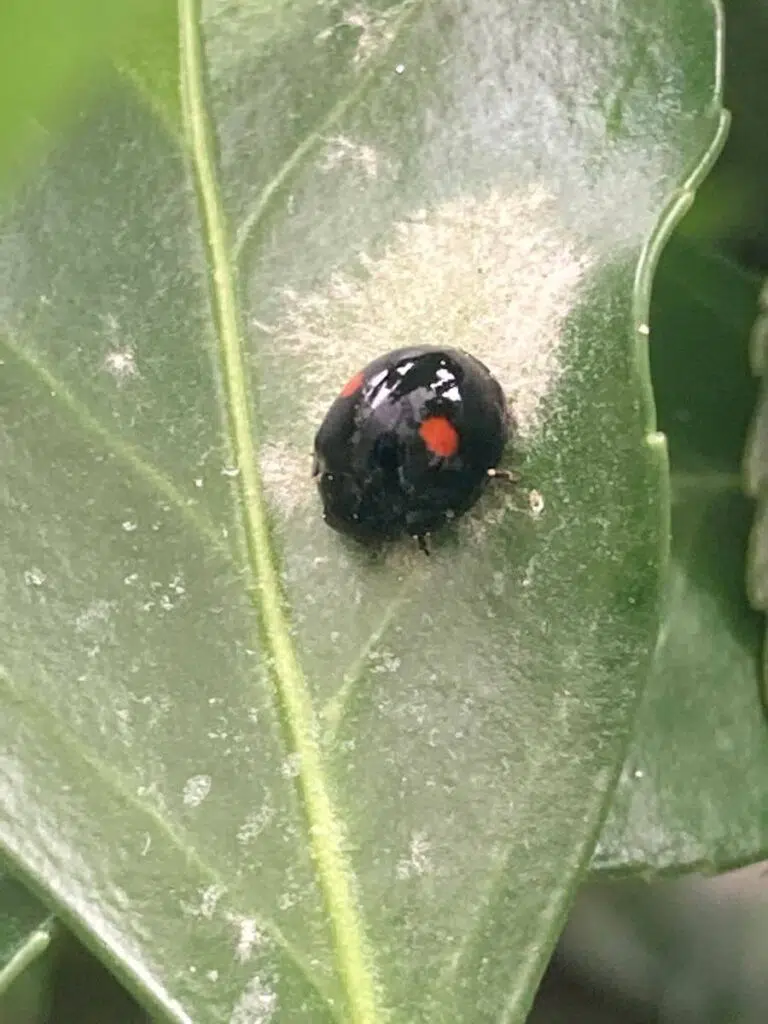
With a black body and red dots, this species (Chilocorus Kuwanae) can easily be confused with other similar black ladybugs. However, its red dots are always located towards the middle of the elytra.
Its red spots are square compared to the round red spots seen on lookalike black ladybugs.
12. Yellow-shouldered Ladybird

This species of black ladybug (Apolinus Lividigaster) gets its name from the yellow spots on the prothorax.
Only 2 yellow spots on the body and 1 yellow spot on the head make this species stand out among other black ladybugs.
Its distinct coloring is a rare sight as the species is only native to Australia and New Zealand.
13. Kidney-spot Ladybird

This black ladybird (Chilocorus Renipustulatus) is mostly found in forests. It prefers oak forests and it may sometimes be found next to rivers on willow trees.
Both young and adult Kidney-spot Ladybirds are known to be predatory. They exclusively feed on scale insects.
One of the easiest methods to identify Kidney-spot Ladybirds is by their body shape. These ladybugs have flattened elytra side edges.
Black Ladybug Spiritual Meanings
Without a doubt, black ladybugs have polarizing spiritual meaning. On one hand, some believe solemn black is associated with death and solemnity.
On the other hand, some people see black as an elegant mature protective color. The following spiritual meanings of black ladybugs are unique and not truly specific to red or too yellow ladybugs.
A protector of crops
The role of protector is first attributed spiritually to black ladybugs. This can either be explained through the protective or absorbent nature of the black color or through the diet of these ladybugs that eat pests on crops.
The guardian role of this species is known to be the most important for farmers. Black ladybirds are mostly predators. They feed on invasive species in agriculture such as aphids.
Hundreds of black ladybugs can quickly eliminate aphids on an acre of farmland. Farmers are known to purchase these lucky black ladybugs to eliminate all invasive insects.
A good luck symbol
Ladybugs are immediately associated with good luck. These bugs are known for their positive role and they are never seen as a precursor to something bad that’s going to happen.
Unlike other black bugs or black beetles, these bugs are seen as a very fortunate event or as a sign that something good is about to happen.
A sign of blessings
Something good might already be happening when you see black ladybugs. These solemn dome-shaped ladybugs are known for their role in blessings.
All blessings can be encompassed in certain areas of life.
Wealth
Black ladybugs can be a sign of blessings in wealth. Money coming in more than usual or more than for other people might be associated with the event of seeing a black ladybug.
Career
New career opportunities are often associated with seeing black ladybugs. More opportunities are essentially the precursor for more money and happier life.
Relationships
Like all ladybugs, black ladybugs are known to bring good fortunes to relationships, especially to romantic relationships. Many people believe these ladybugs can signal the beginning of new relationships.
Self-discovery motivator
Death is often associated with the color black. However, black ladybugs aren’t associated with death. They are a signal of self-discovery and the sign that you need to look inside yourself and analyze your life.
A type of ethical life analysis is often tied to seeing these ladybugs around the world. Once you analyze your life you know which direction to take in the future which means black ladybugs are associated with planning and becoming a better version of yourself.
Self-love prompter
A different side of introspection is self-love. Some cultures believe you need to love yourself more when you see black ladybugs.
Some people are truly altruistic. But even these people might need to practice self-love more whenever they see a black ladybug. Once a person is happy others around that person can become happy as well.
A protector from evil spirits
The role of guardian is first associated with crops and farmland. But ladybugs are known to keep evil spirits away or to absorb all negative energies.
Black ladybugs have a role in protecting your family, home, relationship, or career from all evil spirits which mean harm.
Do Black Ladybugs Bite?
Black ladybugs don’t bite. They are known as predatory insects but they cannot and they will not bite people.
Almost all black ladybugs are innately capable of finding pest insects such as scale insects to feed on. Many types of black ladybugs exclusively feed on these insects and they aren’t interested in biting people.
A small number of black ladybugs possess defensive techniques. Some of the species can release a bad odor while others taste bad. These are the only types of actions black ladybugs can take against people.
Are Black Ladybugs Poisonous?
Black ladybirds are seen as poisonous by some predators such as wasps or spiders. However, black ladybugs aren’t poisonous either to animals or to humans.
The combination of black and red or black and orange coloring might make some people believe black ladybugs are poisonous.
A bad taste can also make some animals believe black ladybugs are poisonous. However, this isn’t the case as these bugs only taste bad, without any poison or venom.
A few black ladybug species are known to release a bad odor as a defense mechanism. This is often perceived as a poison by predators. But even these black ladybugs aren’t poisonous.
What Do Black Ladybugs Eat?
Black ladybugs have very specific dietary habits. They are known to eat pest insects exclusively or they are known to mostly eat invasive pest insects.
These bugs may occasionally feed on plant nectar, especially when there are no insects to prey upon.
Scale insects

Scale insects on trees are the main food of black ladybugs. These types of insects harm trees, eating their leaves and settling in tree bark to the extent they can kill a tree.
Black ladybugs eating scale insects are seen as the most positive types of ladybug impact as they keep trees healthy and farms safe from invasive pest species.
Aphids
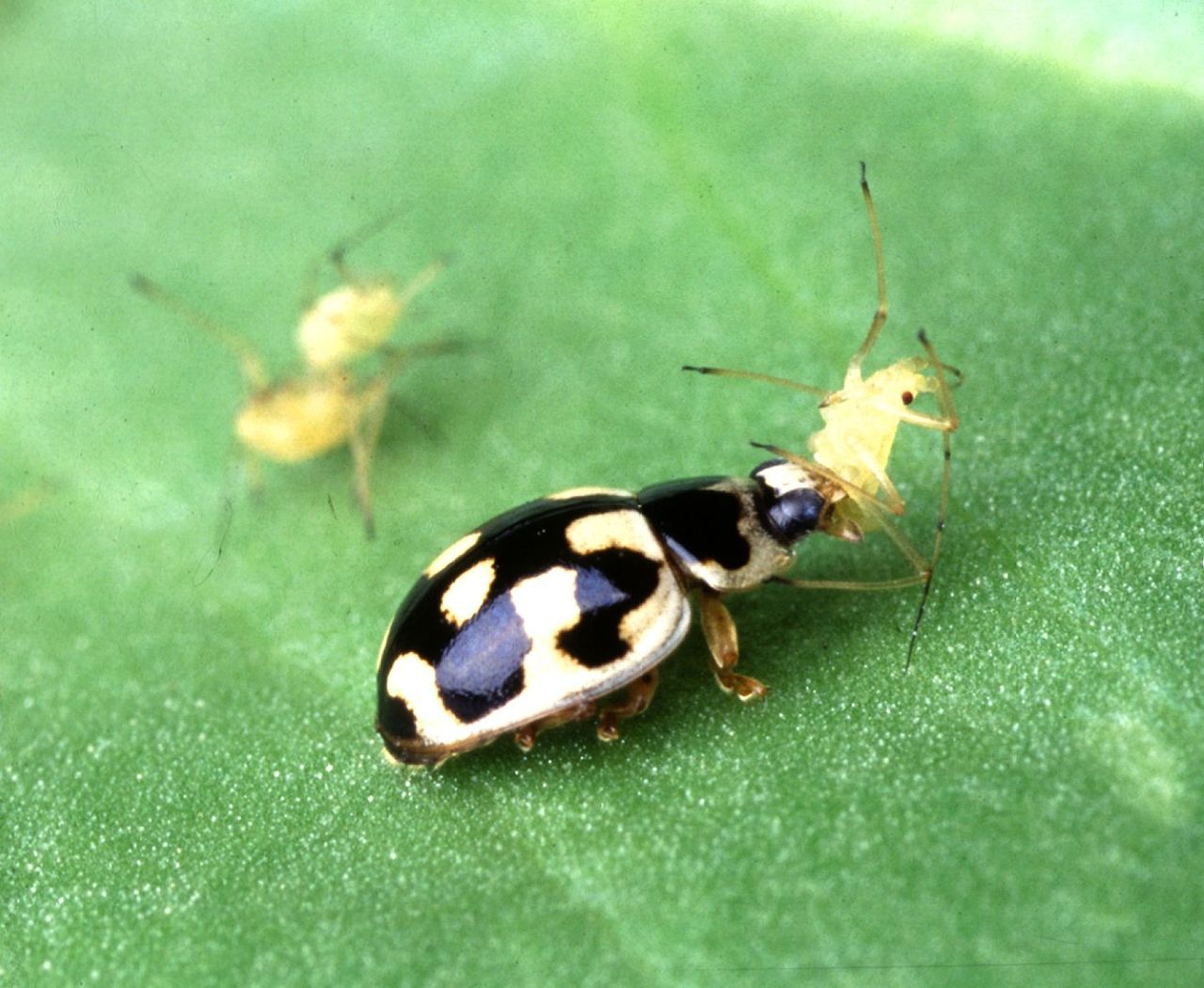
Aphids are sometimes consumed by black ladybugs. However, research shows black ladybugs are a bit less interested in aphids compared to red or yellow ladybugs.
Black ladybugs favor scale insects and will only move on to aphids if they cannot find their favorite prey.
Mites
Black ladybugs can eat spider mites. This is a rare sight, but it happens in certain habitats such as woodlands or riparian zones.
Pollen

Pollen is often consumed by black ladybugs, especially by the species that live in grassland and zones with sufficient flowers.
Nectar
Nectar is consumed together with pollen by a small percentage of black ladybugs. It’s typically harder to see a black ladybug eating nectar than it is to see a black ladybug eating scale insects.
How to Get Rid of Black Ladybugs
Getting rid of black ladybirds is not a high priority for farmers who use them to get rid of pest insects. However, too many black ladybugs in the house quickly become an uncomfortable situation.
One of the best actions to take against these lucky-brining ladybugs is to seal all possible entrances. Here’s what else you can do to keep them out.
Turn off the lights
Black ladybugs can fly. They are also attracted to light. It might be wise to only turn on the lights at night in rooms you use instead of keeping them on all around the house and on the porch.
Yellow light isn’t known for keeping black ladybugs away. This is why you should switch off the lights you don’t use around the house to minimize the risk of them being attracted indoors.
Install window screens

Installing window screens is one of the best methods to keep black ladybugs out. You need some of the finest mesh window screens to keep these bugs out as some can be as small as 2mm.
Window screens should be installed on most windows or on the windows of your home you open. This includes small basement windows which might be left often around the year.
Use duct tape on air vents
Duct tape might be the cheapest solution to seal off the window and door cracks. You can use duct tape on air vents as well.
Strong air currents can bring in black ladybugs. This is why you want to stay away from this possibility, especially if your house is on a farm, next to the water, or next to a field of flowers where black ladybugs like to live.
Vacuum the home frequently
Vacuuming and sweeping are highly recommended when it comes to keeping all bugs out. Small black ladybugs might even be invisible so it’s best to use a potent vacuum cleaner frequently.
Typical areas that need to be vacuumed include floors, walls, corners, basements, bathrooms, and even outdoor areas such as the patio or the garage.
Black ladybugs can multiply quickly and frequent vacuuming is recommended, especially from March to November.
Plant repelling flowers and plants

Basil and lavender are some of the plants that naturally deter black ladybugs. You can plant these flowers in pots and arrange them around the house to easily keep these ladybugs and other types of bugs and pests away.
Try to reduce indoor heat
Heat is one of the main reasons black ladybugs make their way indoors. Turning down the heat might not be feasible during the night.
Some homes can function with lower temperatures in rooms that aren’t often used, such as basements, attic rooms, or even the kitchen. It’s best to refrain from heating your home too much when the outdoor temperature drops as this are the time ladybugs try to make their way indoors.
Use insecticide outdoors
The insecticide isn’t recommended against ladybugs. In case of invasions, it’s best to only apply insecticide outdoors. You can spray around the house and around fences to keep ladybugs and other bugs and insects away.
Don’t grow plants indoors
Some plants are known to attract pests. Insects such as aphids are particularly appealing to black ladybugs. This is why you want to refrain from keeping plants indoors as they can attract the insects black ladybugs eat.
Prune trees and shrubs to keep scale insects away
Most black ladybugs are interested in scale insects. But scale insects are rarely found indoors. They are mostly found on trees and shrubs.
Eliminating or controlling scale insects is needed to truly control black ladybugs. This is done by frequent pruning and even by applying deterring substances on trees and shrubs.
Pruned trees are less likely to suffer from invasive insect damage. This is why all trees around homes and farms should be pruned in the spring to limit the spread of scale insects.
Summary
There are many types of black ladybugs. Some are known to be almost entirely black while most of them are known to have colored (mostly red or orange) spots or marks on the elytra.
These spots are always of a fixed number which sometimes inspires the name of these ladybugs.
Black ladybug names are also inspired by the location of the colored marks on their bodies. For example, the Twice-stabbed Lady Beetle looks like it has been stabbed as it has 2 red marks on opposing areas of its elytra.
Black ladybugs are further known as beneficial species that eat insects that feed on plants and trees.
These are friendly ladybugs that don’t bite and that are often associated with protection, imminent success, and signs of new beginnings.
The spiritual meaning of black ladybugs tends to be interpreted deeply compared to the spiritual meaning of red ladybugs which are mostly associated with love and friendship. Black ladybugs are a protector of farms and agricultural fields. Some cultures believe you have to practice self-love more whenever you see a black ladybug.
Further Reading: